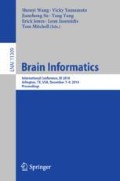Abstract
Advancing the knowledge about neural speech mechanisms is critical for developing next-generation, faster brain computer interface to assist in speech communication for the patients with severe neurological conditions (e.g., locked-in syndrome). Among current neuroimaging techniques, Magnetoencephalography (MEG) provides direct representation for the large-scale neural dynamics of underlying cognitive processes based on its optimal spatiotemporal resolution. However, the MEG measured neural signals are smaller in magnitude compared to the background noise and hence, MEG usually suffers from a low signal-to-noise ratio (SNR) at the single-trial level. To overcome this limitation, it is common to record many trials of the same event-task and use the time-locked average signal for analysis, which can be very time consuming. In this study, we investigated the effect of the number of MEG recording trials required for speech decoding using a machine learning algorithm. We used a wavelet filter for generating the denoised neural features to train an Artificial Neural Network (ANN) for speech decoding. We found that wavelet based denoising increased the SNR of the neural signal prior to analysis and facilitated accurate speech decoding performance using as few as 40 single-trials. This study may open up the possibility of limiting MEG trials for other task evoked studies as well.
Access this chapter
Tax calculation will be finalised at checkout
Purchases are for personal use only
References
Indefrey, P., Levelt, W.J.M.: The spatial and temporal signatures of word production components. Cognition 92(1), 101–144 (2004)
Booth, J.R., Wood, L., Lu, D., Houk, J.C., Bitan, T.: The role of the basal ganglia and cerebellum in language processing. Brain Res. 1133, 136–144 (2007)
Ackermann, H.: Cerebellar contributions to speech production and speech perception psycholinguistic and neurobiological perspectives. Trends Neurosci. 31(6), 256–272 (2008)
Laureys, S.: The locked-in syndrome: what is it like to be conscious but paralyzed and voiceless? Progress Brain Res. 150, 495–611 (2005). The Boundaries of Consciousness: Neurobiology and Neuropathology
Duffy, J.: Motor Speech Disorders Substrates, Differential Diagnosis, and Management, 3rd edn, p. 295. Elsevier, St. Louis (2012)
Herff, C., Schultz, T.: Automatic speech recognition from neural signals: a focused review. Front. Neurosci. 10, 429 (2016)
Wolpaw, J.R., Mcfarland, D.: Control of a two-dimensional movement signal by a noninvasive brain-computer interface in humans. PNAS 51, 49–54 (2004)
Yoshimura, N., et al.: Decoding of covert vowel articulation using electroencephalography cortical currents. Front. Neurosci. 10, 175 (2016)
Birbaumer, N.: Brain computer-interface research: coming of age. Clin. Neurophysiol. 117(3), 479–483 (2006)
Brumberg, J.S., et al.: Brain computer interfaces for speech communication. Speech Commun. 52(4), 367–379 (2010)
Leuthardt, E.C., Cunningham, J., Barbour, D.: Brain-computer interface research. In: Guger, C., Allison, B., Edlinger, G. (eds.) Towards a Speech BCI Using ECoG. SpringerBriefs in Electrical and Computer Engineering, pp. 93–110. Springer, Heidelberg (2013). https://doi.org/10.1007/978-3-642-36083-1_10
Herff, C., et al.: Brain-to-text: decoding spoken phrases from phone representations in the brain. Front. Neurosci. 9(217), 1–11 (2005)
Dash, D., Abrol, B., Sao, A., Biswal, B.: The model order limit: deep sparse factorization for resting brain. In: IEEE 15th International Symposium on Biomedical Imaging (ISBI), pp. 1244–1247 (2018)
Dash, D., Abrol, B., Sao, A., Biswal, B.: Spatial sparsification and low rank projection for fast analysis of multi-subject resting state fMRI data. In: IEEE 15th International Symposium on Biomedical Imaging (ISBI), pp. 1280–1283 (2018)
Formisano, E., De Martino, F., Bonte, M., Goebel, R.: Who is saying what? Brain-based decoding of human voice and speech. Science 322, 970–973 (2008)
Cohen, D., Cuffin, B.N.: Demonstration of useful differences between magnetoencephalogram and electroencephalogram. Electroencephalogr. Clin. Neurophysiol. 56(1), 38–51 (1983)
Chan, A.M., et al.: Decoding word and category-specific spatiotemporal representations from MEG and EEG. NeuroImage 54(4), 3028–3039 (2011)
Wang, J., Kim, M., Hernandez-Mulero, A.H., Heitzman, D., Ferrari, P.: Towards decoding speech production from single-trial Magnetoencephalography (MEG) signals. In: IEEE International Conference on Acoustics, Speech and Signal Processing (ICASSP), pp. 3036–3040 (2017)
Dash, D., Ferrari, P., Malik, S., Wang, J.: Overt speech retrieval from neuromagnetic signals using wavelets and artificial neural networks. In: IEEE Global Conference on Signal and Information Processing (GlobalSIP) (2018)
Gross, J., Baillet, S., Barnes, G.R., Henson, R.N., Hillebrand, A., Jensen, O., Schoffelen, J.-M.: Good practice for conducting and reporting MEG research. Neuroimage 65(100), 349–363 (2013)
Attal, Y., et al.: Modelling and detecting deep brain activity with MEG and EEG. IRBM - Biomed. Eng. Res. 30, 133 (2009)
Burgess, R.C., Funke, M.E., Bowyer, S.M., Lewine, J.F., Kirsch, H.E., Bagi, A.I.: American clinical magnetoencephalography society clinical practice guideline 2: presurgical functional brain mapping using magnetic evoked fields. J. Clin. Neurophysiol. 28, 355–361 (2011)
Grill-Spector, K., Henson, R., Martin, A.: Repetition and the brain: neural models of stimulus-specific effects. Trends Cogn. Sci. 10(1), 14–23 (2006)
Cheyne, D., Ferrari, P.: MEG studies of motor cortex gamma oscillations: evidence for a gamma fingerprint in the brain? Front. Hum. Neurosci. 7, 575 (2013)
Dash. D., Kim, M., Ferrari, P., Wang, J.: Brain activation pattern analysis for speech production decoding from MEG signals. In: 25th Annual meeting of Biomedical Engineering Society (BMES) (2018)
Tadel, F., Baillet, S., Mosher, J.C., Pantazis, D., Leahy, R.M.: Brainstorm: a user-friendly Application for MEG/EEG analysis. Comput. Intell. Neurosci. 8, 8:1–8:13 (2011)
Acknowledgment
This project was supported by the University of Texas System Brain Research grant and by the National Institutes of Health (NIH) under award number R03 DC013990. We thank Dr. Mark McManis, Dr. Ted Mau, Dr. Angel W. Hernandez-Mulero, Kanishk Goel and the volunteering participants.
Author information
Authors and Affiliations
Corresponding author
Editor information
Editors and Affiliations
Rights and permissions
Copyright information
© 2018 Springer Nature Switzerland AG
About this paper
Cite this paper
Dash, D., Ferrari, P., Malik, S., Montillo, A., Maldjian, J.A., Wang, J. (2018). Determining the Optimal Number of MEG Trials: A Machine Learning and Speech Decoding Perspective. In: Wang, S., et al. Brain Informatics. BI 2018. Lecture Notes in Computer Science(), vol 11309. Springer, Cham. https://doi.org/10.1007/978-3-030-05587-5_16
Download citation
DOI: https://doi.org/10.1007/978-3-030-05587-5_16
Published:
Publisher Name: Springer, Cham
Print ISBN: 978-3-030-05586-8
Online ISBN: 978-3-030-05587-5
eBook Packages: Computer ScienceComputer Science (R0)

